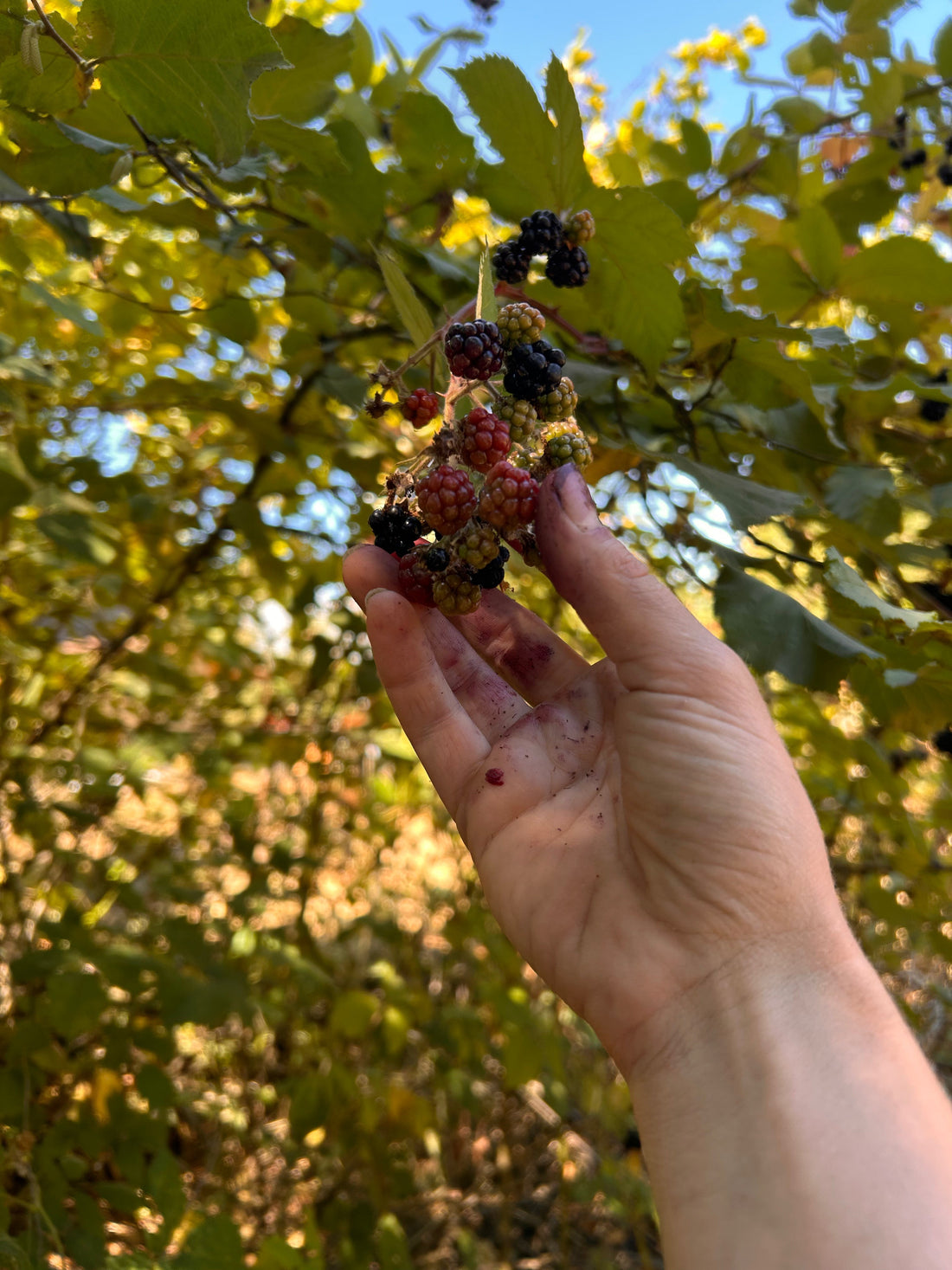Summer Foraging
Late summer is here, and there is still time to get out and forage—especially for berries. They're super juicy, abundant and free for the picking.
Across the world— Slavic and Nordic cultures come to mind—wild harvesting is a deep-rooted tradition practiced eagerly even today. In Sweden, for example, public access laws even allow foraging on private land. Foraging stirs the same passion in some people as hunting does in others. Both tap into something ancient—think of kids on an Easter egg hunt. It’s the same instinct, but for grown-ups and with more wholesome rewards.
Oregon is a forager’s dream: truffles, berries, horsetail shoots, fir tips. Some finds are fleeting—like horsetail shoots or spring fir tips—while others, like nettles and blackberries, can be harvested throughout much of the summer season.
Oregon’s foraging laws are quite generous, allowing personal-use harvesting on state forest land. Did you know that one can take up to 25 ten-foot alder poles in a single trip- for your corral of course! One may gather up to 16 grocery bags of boughs, ferns and lichen or collect a quart of truffles per vehicle. (If you’re serious about your haul, maybe skip the carpool.)
I like to think of foraging in three categories:
· The “will you look at that!” foraging—Trying a nibble of thimbleberry or digging up a handful of Camas bulbs just to see what it’s like. It’s curiosity-driven and indulging my “Robinson Crusoe-living off the land” fantasies that I have had since I was a child!
· The high-value kind—Truffles, ginseng, matsutake. This is serious business, something people are competitive about. To the point of carrying handguns to ward off fungi robbers. I don’t dabble in this since I don’t have the time or expertise, and we all know that the good stuff is hard to find.
· And finally, the practical kind—gathering enough to actually use, preserve and incorporate into our products. We are fortunate living on a farm with old fruit trees and even wild ones- we just finished picking heaps of juicy blackberries for our Blackberry Ginger Jam for our seasonal chevre. Find it at Beaverton and PSU Farmers Market on Saturday!
Every year, I pick heaps of nettles and blackberries—enough for our pantry and for our products. The nettles in our hand balm? Foraged. The berries in our blackberry ginger chevre? Same. And you don’t need to live on a century old farmstead to do this yourself – nettles and blackberries are widespread- if you know where to look.
I remember being baffled by people buying blackberries at the farmer’s market. Why pay for something that grows for free around the parking lots? The wild ones are smaller than the cultivated kind, but the flavor? Compare a huckleberry to a store bought blueberry- Not even in the same category!
While Huckleberries are a passion for folks in Oregon they are very specific in their habitat (high alpine) and often get over foraged. I stick to blackberries- they are so abundant that folks buy goats from us to eradicate them on their acreage!
Blackberries are a lifelong thing for me. I remember coming back from the berry patch with my dad, each of us with a milk can swinging from the handlebars of our bikes. That was half a century ago, and I’ve been picking blackberries ever since. I never thought that there was knowledge needed or lack thereof could be a barrier to folks until a centenarian Portland resident set me straight:
Lina had grown up in Nebraska during the Dust Bowl and had never seen even a single tall tree until she arrived in Portland in the early 1940’s. She described to me being overwhelmed by the canopy of green and bewildered by roadside blackberries, “I was just a young thing and I knew little about the world so I had to go ask someone if I could pick them for myself.” Lina was told to go ahead and pick to heart’s desire. “I packed my whole brown lunch bag full, it seemed like such a treasure, then on the streetcar ride home, the bottom of the bag gave out, and the berries spilled everywhere and I felt like such a fool”.
So that no-one else has to feel like a fool- here are my tips for:
Blackberry Picking:
First off- this is safe- there are no poisonous berries that look anything like a blackberry. Some folks new to foraging must overcome the thought that food is only safe to eat if it’s being sold to you by store or a market vendor. Not true! Fields of berries in the wild or on a farm can equally be pooped on by birds flying overhead.
The fresh fruit of most wild berry bushes is generally safe to eat right off the plant—I do it all the time. If you're concerned about pathogens like fox tapeworm or other wildlife-borne risks you can always wash or cook your harvest. Heating to 165°F is the standard threshold for killing most harmful organisms.
· Blackberry patches bloom with white flowers, making them easy to spot. The red berries follow until the whole lot is heavy with juicy black berries by mid July. Urban areas have plenty of blackberries at the edge of parks and wildlife areas. Private properties with canes billowing over fences might let you pick as well- if in doubt just knock and ask!
· Avoid patches of berries directly by roadsides.
· Aside from herbicide risk, older roadways may have legacy lead-contaminated soil. Back in the 70’s it was thought to improve fuel efficiency to add lead to gasoline. By 1996 it was phased out but some of the lead lingers in the soil. Pick a spot that is away from the road and unlikely to have been sprayed with herbicide.
· Gear: Bring a step stool or sturdy bucket to stand on for reach- brambles grow up to 12’tall and the best berries are just out of reach. I wear long sleeves of canvas or other sturdy cloth and use a leather glove for my branch-holding hand.
· Use a gallon jug with a 3-4” cut near the top and hang it from your waist to keep both hands free. This works well for cherries too!
· When the jug is mostly full transfer the berries into shallow layers to avoid crushing. Paper grocery bags with folded-down sides work well so do cardboard flats.
· Early berries (first flush) are high in pectin. When only one or two are ripe in each cluster pick them and freeze them- you can later add them to the main jam batches so you don’t need commercial pectin.
You can freeze your haul if you're not ready to process it right away. Spread them in a single layer on a baking sheet or tray and transfer to bags when frozen solid so they don’t clump.
I use them throughout the year for cakes and smoothies and as a topping for ice cream but cooking jam or jelly is a summer ritual that I would hate to miss. The difference between jelly and jam… are the seeds. When making jam the fruit is processed just as it is, for jelly you strain the juice and only process this. Blackberries do have seeds, but I don’t mind them one bit. It’s a matter of preference but the jam is delicious and has a higher yield while taking less time to make so usually I opt for jam.
If you have never made jam, make it this year- it’s easier than you think and the resulting case of jam should do you for many PB+J’s or make lovely holiday gifts.
Here is my favorite simple recipe for low sugar Blackberry jam.
Yield: About 12 half-pint jars (6 pints)
Ingredients:
· 24 cups fresh blackberries (about 7–8 lbs) That’s about three gallon jugs of picked berries!
· 4½ cups sugar (you can reduce to 3½ cups if you prefer it more tart)
· ¾ cup fresh lemon juice (about 4–5 lemons)
· Optional but lovely- three 1” knobs of ginger sliced thin and removed after cooking you can also use other warm spices like Cinnamon, nutmeg, clove or all spice. Make your very own version of spiced blackberry jam!
· For a more herbaceous flavor try a sprig of rosemary or thyme- also removed after cooking.
Instructions:
1. Prep the berries: Rinse and sort the blackberries. In a large, wide-bottomed pot (like a preserving pan or stockpot), mash the berries to release their juices. I don’t’ remove the seeds from the jam but you could by running them through a food mill. It’s tedious and messy but results in a slightly fancier product- Blackberry Jelly!
2. Add sugar and lemon juice: Stir in the sugar and lemon juice.
3. Cook: Bring the mixture to a boil over medium-high heat, stirring often. Reduce heat to maintain a steady simmer and continue cooking uncovered, stirring frequently, for 45–60 minutes or until thickened. The volume should reduce significantly. The jam can scorch easily so keep an eye on it and stir often.
4. Test for doneness: Use the cold plate test: place a spoonful on a chilled plate, let it sit a minute, and run your finger through it. If it wrinkles or holds a clean line, it’s done.
5. Jar and process: Ladle hot jam into sterilized half-pint jars, leaving ¼-inch headspace. Wipe rims, apply lids and rings, and process in a boiling water bath for 10 minutes (adjust for altitude if needed).
6. While you are in the kitchen cleaning up- (things might be a little sticky) - you can listen to one jar after another softly “popping” it’s the sound of the lid creating a vacuum while it’s content cools down and constricts. When cooled down the center of all the lids should be “sucked down” and pushing on them should not “pop”. If you find one that is not down– put it in the fridge and eat it first. Jars with a vacuum are now shelf stable for up to two years- I suppose that’s why it’s called “preserve”.

